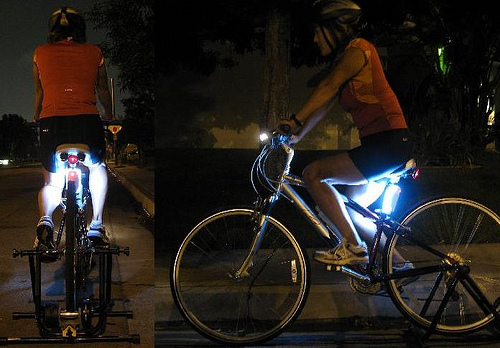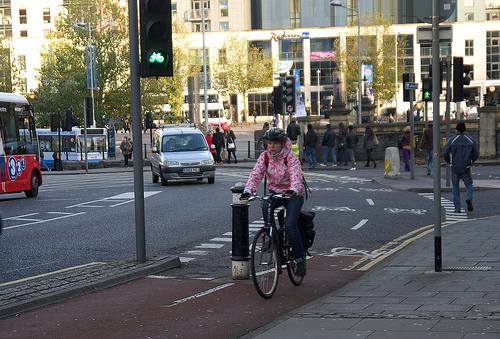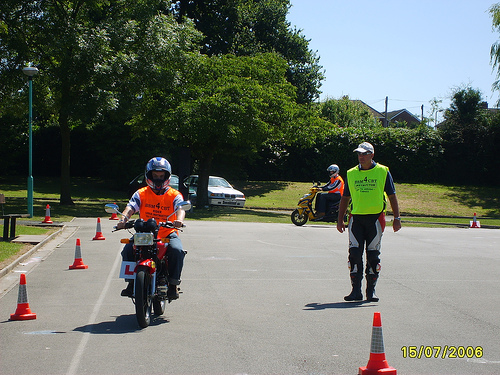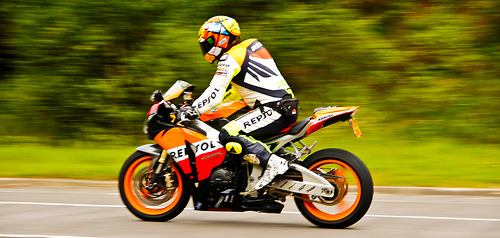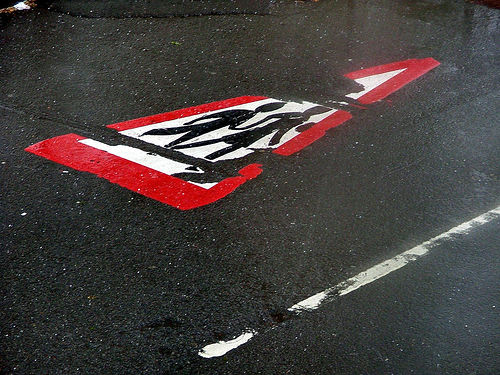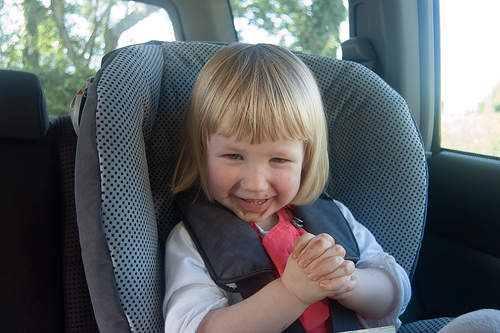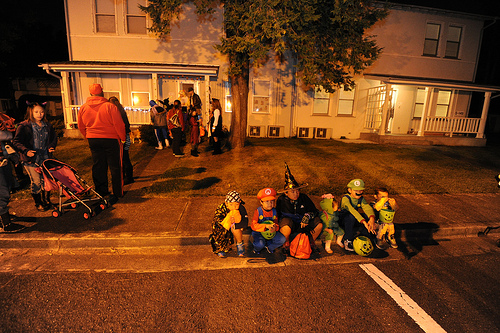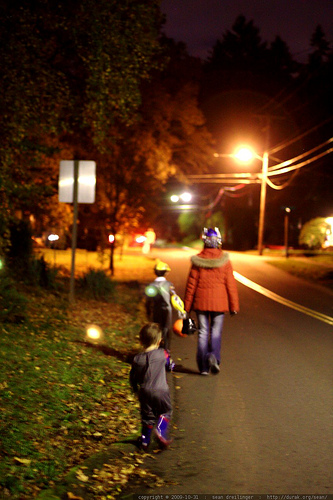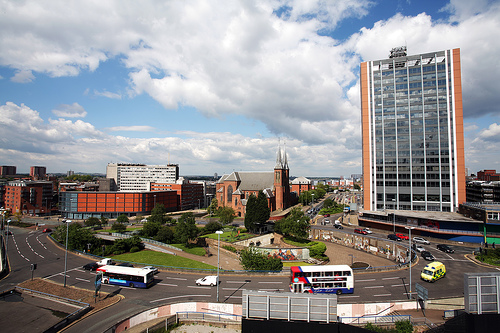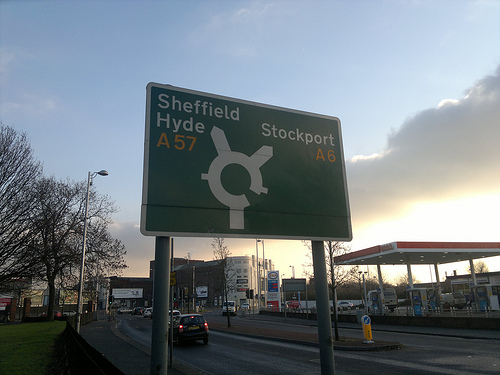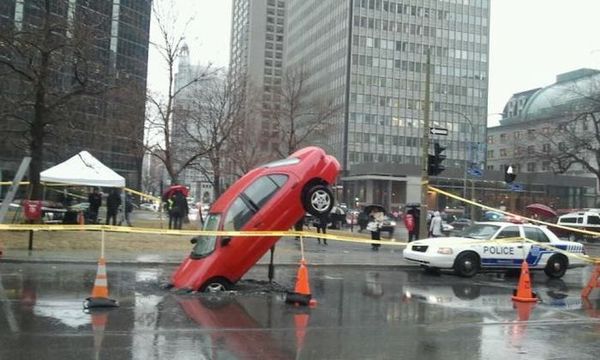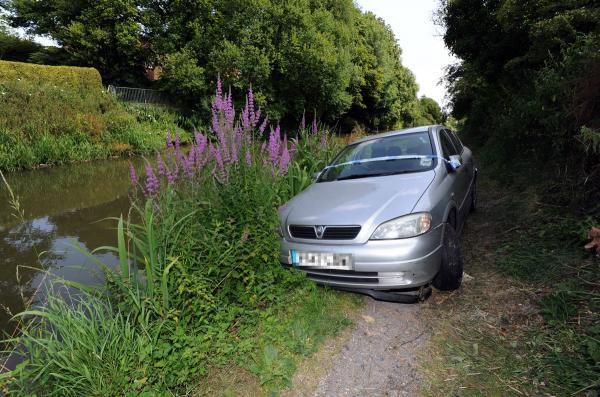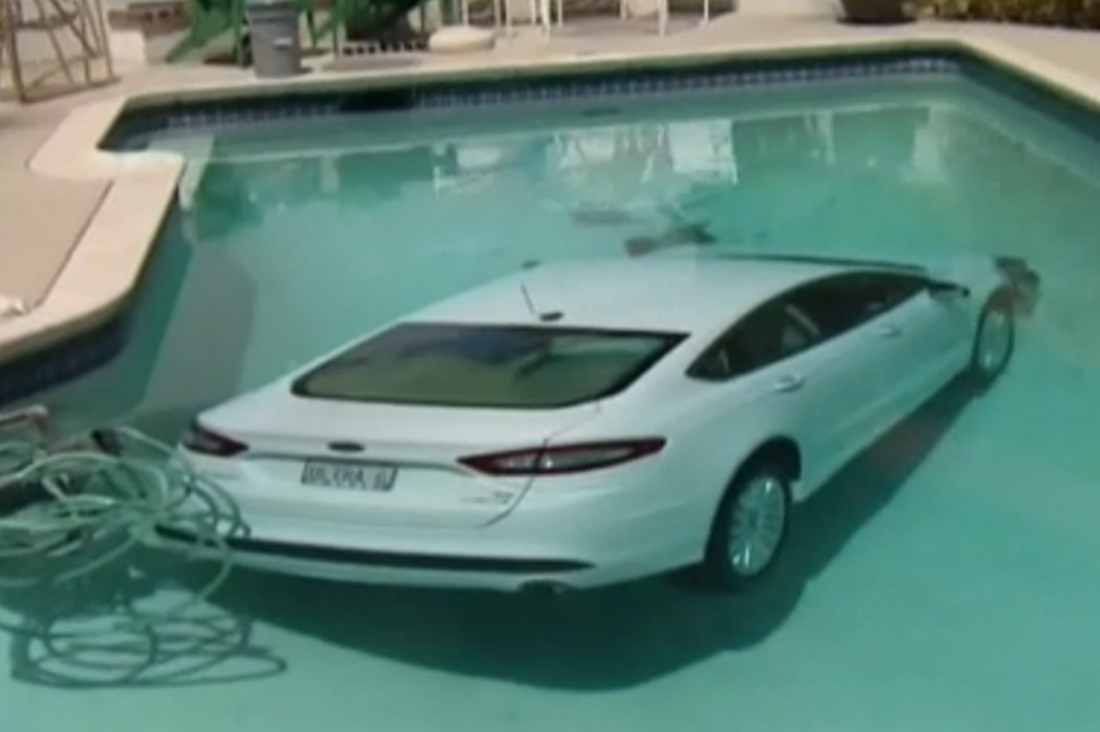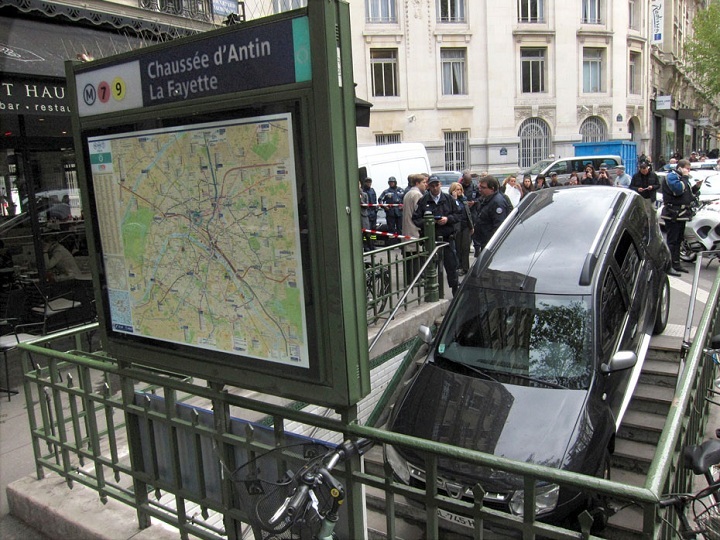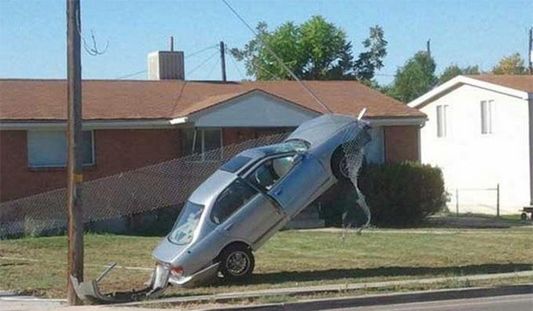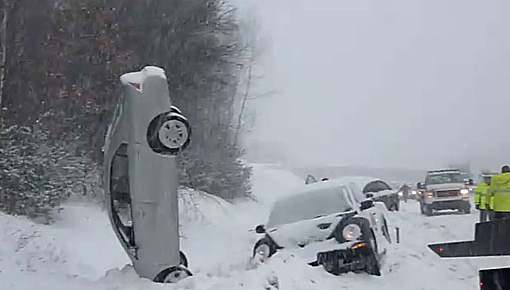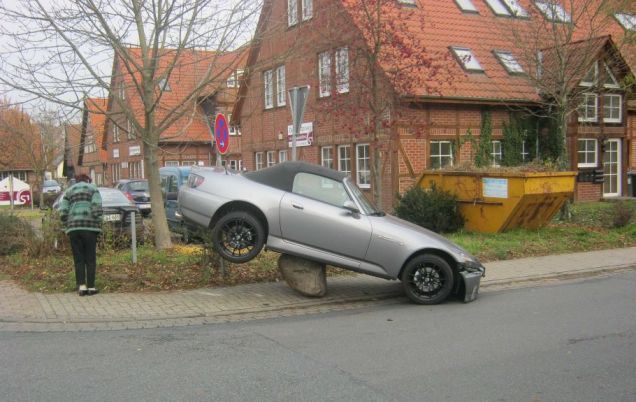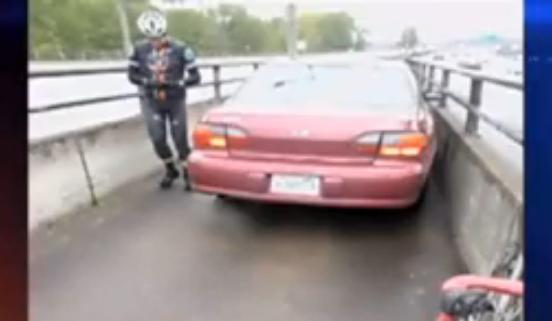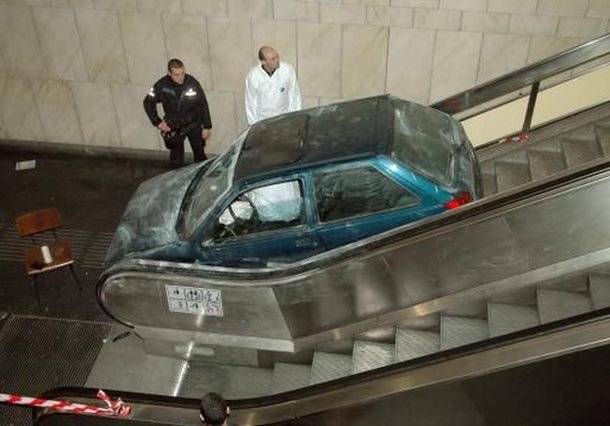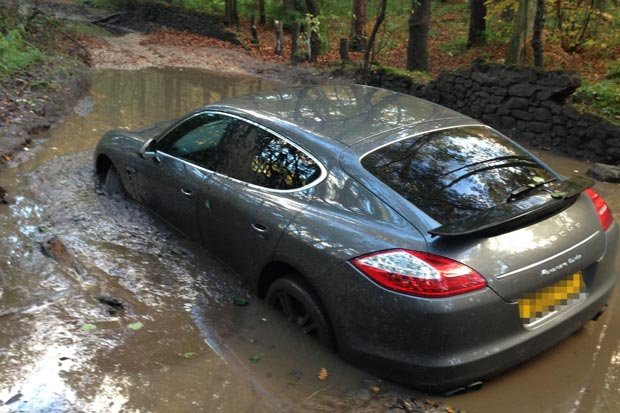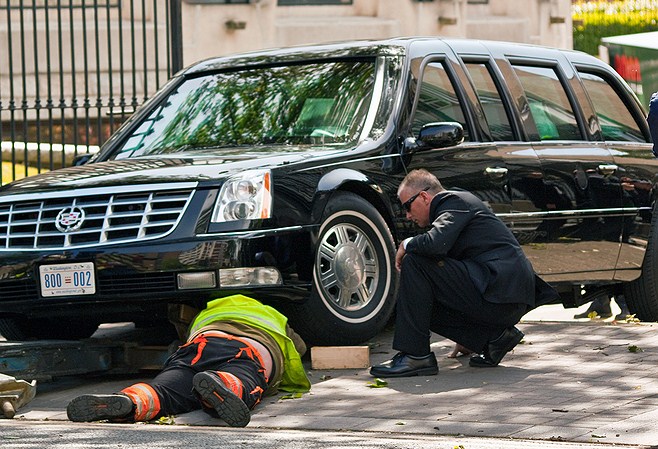|
According to the THINK! Cycling Campaign, the number of cyclists seriously injured has increased in recent years, faster than the increase in cyclists on the roads. If you are planning to start cycling on the road, it is important to make sure you have a full understanding of the Highway Code and know how to keep yourself safe. Below we have outlined some of the key rules from the Highway Code for cyclists to follow. Section 59 Section 59 of the Highway Code explains the appropriate clothing cyclists should wear in order to make it easier for other road users to spot them and help to keep them protected in the case of a collision. Cyclist clothing:
This section of the Highway Code is all about cyclists’ lights and reflectors. At night cyclists must have their white front and red rear lights lit. Their bicycles must also be fitted with a red rear reflector and amber pedal reflectors. White front reflectors and spoke reflectors can also increase your visibility to other road users. Flashing lights are permitted but cyclists riding in areas without street lighting should use a steady front lamp instead. Section 61
Section 61 covers cycle routes and other facilities for cyclists. If cycle routes are available cyclists should make use of them, as they can make their journeys safer. Cyclists should also use advanced stop lines, cycle boxes and toucan crossings, unless it is unsafe to do so. Section 62 Section 62 covers the use of cycle tracks, which can be used to make a journey safer. Cycle tracks are usually located away from the road, but are sometimes found alongside footpaths and pavements. Sometimes cycle tracks will have a separate path for pedestrians, however this is not always the case. If you are using a segregated path, it is important to make sure you stay on the right side of the track to avoid colliding with pedestrians. Be on high alert in case pedestrians pass into your lane without realising. If you are sharing a path, take extra care and give plenty of room to children, the elderly and disabled people. You should always be riding at a speed that would allow you to slow down and stop if necessary. Section 63 Cycle lanes are marked by a white line (which may be broken) and are found alongside the carriageway. Although not compulsory, you should use the lanes whenever practical as they can make your journey safer. If you need to leave the cycle lane, always check that it is safe to do so and signal to other road users. Section 64 Something that confuses many cyclists is whether or not they are allowed to cycle on the pavement. According to Laws HA 1835 section 72 & RSA 1984, section 129, cyclists must not cycle on the pavement. Section 65 Cyclists can use bus lanes when permitted to by road signs. Take extra care and watch out for people getting on or off buses. Only overtake a bus pulling into a bus lane if it is safe to do so. Do not pass between the kerb and a bus when it is at a stop. Section 66 This section explains what cyclists should and should not do when riding on the road. You should:
Follow the steps below to promote safety on the roads:
Cyclists should not carry a passenger on their bicycle, unless it has been build to carry one. They must not ride in a dangerous, careless or inconsiderate manner. Cyclists must not ride under the influence of alcohol or drugs (including some medications). Section 69 Traffic signs and traffic light signals apply to all road users. Cyclists must obey them. Section 70 Just as there are parking rules for vehicles, there are also ones for cyclists. You should always aim to use cycle stands of cycle parking facilities wherever possible and avoid leaving your bike where it would cause an obstruction or hazard to others. Section 71 A red traffic light applies to all road users. Cyclists must not cross the stop line if the traffic lights are red. Use the separate stop line for cyclists when practical. We hope this article has helped you gain a better understanding of the Highway Code for cyclists and given you more confidence in riding safely on the road. If you have any questions feel free to get in touch. Image source: Richard Masoner and samsaundersleeds
160 Comments
Are you thinking of buying a motorbike? Before you can ride it on the road, you will need to follow the Highway Code by completing a Compulsory Basic Training course, also known as a CBT. Once you have passed the CBT you will be permitted to ride unaccompanied on the public road on a motorcycle up to 125 cc, with a power output not exceeding 11 kW. You must also ride with L-plates for up to two years. What does the CBT involve? The CBT course is designed to equip motorcyclists with the basic skills they need to ride safely on the road. Attendees are given a basic introduction to road safety and must carry out an eye test. They then have to do practical training, which teaches them how to control a bike, how to use gears, how to stop and start and how to carry out relevant safety checks. During the CBT course, motorcyclists have two hours accompanied on the road with a certified instructor. The instructor ensures that motorcyclists have the knowledge and skills to drive safely on the road and have a full understanding of the basics. If you successfully complete the CTB course, you will be given a DL196 certificate that permits you to ride a motorcycle solo up to 125cc, providing you are at least seventeen years old. You must display L-plates on the front and rear and must not carry passengers or ride on the motorway. Getting your full motorbike licence After passing your CBT, you will have two years to pass the theory and practical test to gain their full motorbike licence. If you do not pass within this time period, you will be required to retake your CBT. In order to gain your full motorbike licence you will need to first pass a theory test. This involves answering multiple-choice questions and completing a hazard perception test. Once you have passed your theory test, you will be able to take your practical motorcycle test. It is recommended that you read up on the Highway Code and have formal training beforehand. There are two types of full motorcycle licence. The first is a light motorcycle licence (A1) that restricts riders to any bike up to 125 cc and a power output of 11 kW. The standard motorcycle licence (A) restricts you to riding a bike up to 25 kW and a power / weight ratio not exceeding 0.16 kW / kg for the first two years. However after this period you can ride any size of bike. Highway Code rules for motorcyclists Section 83
All motorcyclists and pillion passengers must wear protective helmets. Helmets must comply with the regulations and should be fastened securely. This applies to riders of motorcycles, scooters, mopeds, tricycles and quad bikes. Section 84 Motorcyclists are advised to wear eye protectors that comply with the regulations. If they eye protectors are scratched or poorly fitted, it can limit their view and cause potential hazards. It is also recommended that you wear ear protection, as well as strong boots, gloves and suitable clothing that will help to protect you if you are involved in an accident. Section 85 Motorcyclists with a full bike licence are only permitted to carry one pillion passenger who will be required to sit astride the bike on a proper seat. They should sit forward, with both feet on the footrests. You should not carry a pillion passenger if your motorcycle is not designed to do so. Provisional licence holders are not permitted to carry a pillion passenger. Section 86 This section is all about making sure you are visible to other road users when riding in the daylight. Motorcyclists should wear a light or brightly coloured helmet, as well as florescent clothing or strips (often found on motorcycle jackets). Even with the right clothing, it is important to take extra care as other vehicle drivers may not see you or be able to judge your distance or speed correctly. Section 87 This section of the Highway Code explains what you should wear to make sure you are visible to other road users in the dark. It is recommended that you wear reflective clothing or strips to improve your visibility. These will reflect the light from the headlamps of other vehicles, helping them to spot you from a longer distance. Section 88 Section 88 of the Highway Code for CBT and motorbikes is all about manoeuvring. It is important that you are aware of what is behind and to the sides of you before manoeuvring. In traffic queues, you should always look for pedestrians crossing between vehicles, as well as vehicles changing lanes and emerging from junctions. Make sure you position your bike so that the drivers in front can see you in their mirrors. Always take great care and when filtering in slow-moving traffic, keep your speed low. We hope we have answered any questions you may have about the Highway Code for CBT and Highway Code for motorbikes in this article. If you would like any more information, feel free to get in touch. Image credits: One-Stop-Down and Natesh Ramasamy The best way to keep your children safe when they are out and about is to ensure they know how to cross a road safely and have a good understanding of the Highway Code. Below we have provided key safety rules that you should follow yourself and teach to your children. Road safety for children Read through the rules below with your children to ensure they understand road safety. It is good to practice with them, so that when they are older and perhaps walking to school on their own, they will know how to get their safely.
How to cross a road safely It is important that your children know how to cross a road safely. This is something that you will need to practice with them, so that they build up confidence in making safe decisions. You can read through the rules below with your children to help them get a better understanding of how to cross roads safely. 1. Find the safest place to cross If there is a zebra, pelican or traffic light crossing, always use it. You can also rely on police officers, school crossing patrols (lollypop men and ladies) as well as traffic wardens to help you cross roads safely. If you cannot find a crossing nearby, make sure you stop in a place where you can see clearly a long the road, from all directions and that road users can see you. 2. Stop and look all around Stand on the pavement, a little way back from the kerb, but so you can see if there are any vehicles coming. Give yourself plenty of time to look around. 3. Look and listen Use your eyes and ears to look all around for traffic and listen. Sometimes you will be able to hear traffic before you can see it. 4. Wait until it is safe to cross If traffic is coming, let is pass. Make sure there is a safe gap and that you have plenty of time to get to the other side, before you begin to cross. 5. Look and listen again When it is safe to do so, walk straight across the road to get to the other side. Keep looking and listening as you do so. Always walk, never run. Clothing for children Here in the UK we get a lot of poor weather. To make your children more visible to road users, it is a good idea to ensure they are wearing bright clothing at night or in bad weather. Fluorescent materials will also be good for highlighting their presence in daylight and at dusk. Reflective materials will do the same, only at nighttime. Child passengers in vehicles
When riding in a vehicle, the law says that seatbelts must be worn at all times. If your child is under the age of twelve and under 135cms in height, they should also use a child seat, designed for their size. Rules for children:
Image credits: Andrew Mason & Mike Roberts NYC Halloween is a fun and exciting holiday, but as a result of increased foot traffic, the potential for vehicle related accidents with young pedestrians is significantly greater. Minimise the risk of accidents on the road by following our Halloween traffic safety tips below. Drive slowly through residential areas Children can be unpredictable at the best of times, let alone when they are excited on a night like Halloween. If you happen to be driving through residential neighbourhoods on Halloween, make sure you drive extra slowly and be especially alert. Take extra time to look out for children When you are driving around on Halloween, make sure you put extra time and effort into looking out for children who may be standing at crossings, junctions and on curbs. Kids can dart out onto the road at any time. They are likely to be caught up in the excitement of trick or treating and will be less aware of cars, so make sure you are watchful of their presence. Signal for children to cross the road Even if you have spent time showing your children how to cross the road properly, be mindful that not all parents will have done the same. Sometimes kids panic when it comes to crossing the roads and their actions can be erratic and dangerous. If you see children waiting to cross the road you are driving on, slow down, stop and providing there are not any cars coming the other way, signal for them to cross in front. Enter and exit driveways slowly Children are likely to be visiting houses in their local neighbourhood trick or treating, so make sure if you are pulling in or out of a driveway, you do it slowly and with great care. Eliminate distractions inside your car As we mentioned before, you will need to be especially alert on Halloween as children can be unpredictable, particularly when they are excited. The best way to keep yourself alert is to minimise any distractions inside your car. Turn the radio off and disable your Bluetooth headset whilst you are driving around residential areas. This will allow you to fully concentrate on the road and your surroundings. Don’t overtake cars that have stopped in the road Remember that parents are likely to be dropping off and picking up their children, so if there is a car stopped in the road, refrain from overtaking it. Children could dart out onto the road to get in the car or exit the car without looking, so you need to be on high alert. If you are dropping off your children, choose a safe spot to stop and make sure you alert other motorists by signalling and putting on your hazard lights. Take extra precautions on the road Anticipate that there is likely to be more pedestrian traffic on Halloween. You may want to consider driving slower than usual and turning on your headlights earlier in the day so you can spot children more easily. Children tend to go trick or treating between 5:00pm and 8:00pm so be especially careful when driving on the road during those hours. Keeping your trick or treaters safe
If your children are planning on going out trick or treating on Halloween, make sure that you spend time going through tips on how to keep safe on the road. Do not let your children out unsupervised if they do not know how to cross a road safely. We also recommend putting reflective tape on your child’s costume to make them more visible to drivers. Whilst equipping them with a flashlight will help them see where they are walking, make sure you tell them not to shine it at drivers, as this could distract them and cause them to temporarily lose control of their vehicles. Follow our Halloween safety tips and help to keep both drivers and pedestrians safe. We hope you have a happy holiday! Image credits: U.S. Army Garrison Japan and sean dreillinger It is fair to say that roundabouts are one of the hardest sections of the Highway Code for beginners to master. Make sure you read through this page a few times until you completely understand it. If you are learning to drive and have any questions, be sure to note them down and ask your driving instructor next time you have a lesson. DRIVING LESSONS ONLINE - that will save you £'s on learning to drive! Start here >> Section 184 Section 184 of the Highway Code is all about what to do when approaching a roundabout. To ensure you approach roundabouts safely you should look out for traffic signs, traffic lights and lane markings, all of which will help you to prepare for manoeuvring around the roundabout and identifying the correct lane. When approaching a roundabout you should:
Section 185 Section 185 explains what you should do when you reach the roundabout. Again it is important to be aware of the traffic around you and look out for road users who may be signalling incorrectly or in some cases not signalling at all! When reaching a roundabout you should:
Section 186 This section of the Highway Code explains the signals and positions required to exit a roundabout safely. Follow the rules and you will find maneuvering roundabouts to be much less stressful. When taking the first exit (unless signs and markings indicate otherwise):
When taking an exit to the right or going full circle (unless signs or markings indicate otherwise):
When taking any intermediate exit (unless signs or markings indicate otherwise):
Section 187
Section 187 explains the road users you should watch out for and give plenty of room to when approaching and entering a roundabout. This includes:
Section 188 This section of the Highway Code is all about mini-roundabouts. You should apply the same rules to approaching and entering mini-roundabouts as you would normal roundabouts. It is important to remember that all vehicles must pass round the central markings, unless they are too large to do so. You will find that when driving around mini-roundabouts there is less room to manoeuvre and less time to signal, so take extra care. Section 189 If you are faced with a double mini-roundabout, make sure that you treat each roundabout separately (approaching and entering them in the same way you would any roundabout) and give way to traffic coming from your right. Section 190 If you are approaching a set of mini-roundabouts (common at complex junctions) you need to treat each of them separately, following the rules stated above. We hope this information has provided you with the knowledge and confidence to approach and enter roundabouts safely. If you have any questions, please don’t hesitate to get in touch. Image credits: MarkyBon and EthelRedThePetrolHead Learning to drive isn’t easy, but you assume that people who’ve passed their test must be good drivers. If they weren’t, surely they’d have failed, right? Wrong. Some people who pass their driving test don’t seem to have a clue. One thing’s for sure, all 11 drivers on this list need an injection of common sense, or possibly a new copy of the Highway Code. 1. Wet concrete = a driver’s worst enemy. Via everythingfunny.org This driver didn’t see the ‘wet concrete’ sign and drove his car onto it. The weight of the front section sinking into the ground made the rear wheels rise into the air, making the car look like it’s been dropped from a great height! 2. Driver ends up on canal towpath. Via gazetteandherald.co.uk An elderly man in Devon took a wrong turn and ended up on a canal towpath earlier this year. Instead of reversing and turning round, he decided to carry on driving along the towpath in the hope he could find an exit. He didn’t: his insurance company ended up having to remove it with a crane. 3. “Is that a submarine?” Via mirror.co.uk Let this be a lesson to sandal wearers: it’s not a good idea to drive wearing flip flops. If you do, you could end up with your car in the swimming pool, which is what happened to this 84 year old in Altadena, California when his shoe got stuck under the gas pedal when driving out of his garage. 4. Car driver tries to take the subway. Via q8allinone.com This French driver seemed to think that it was possible to drive into this underground station in Paris! His car got stuck on the steps when he mistook the entrance for a car park. Zut alors! 5. Back of the net. Via sunnylol.com/driving-fail We can’t overstate the importance of not running into a tennis net while driving along the road. This driver did, and look what happened to him. Tennis net 1, car 0. 6. This situation is ‘snow’ joke. Via automotivepictures.co.uk This driver insisted on trying to drive around a snow drift, only to find his car tipping on end. The snow then froze around the BMW, leaving it sticking out of the ground like a telephone pole. That VW Beetle might end up with a smashed windscreen when the ground thaws! 7. Car gets stuck on a rock. Via metro.co.uk They might make good cars, but this photo proves that German people don’t always make great drivers! This German driver was speeding in a housing estate when his car went into a spin and somehow ended up balanced on this ornamental rock. 8. “Hey, that’s not a bike!” via kgw.com This very confused lady managed to drive more than a MILE down a narrow cycle lane attached to a busy bridge in Portland, Oregon before a group of cyclists stopped her. Did she think it was an extra lane on the highway? You can see a news report about the incident here. 9. Car drives down escalator. Via stevesfunnies.com A confused shopper in a US mall took a wrong turn when looking for the car park and ended up driving down an escalator instead! Thankfully no one was harmed, but the impact did make the cat’s airbag inflate. Might be best to leave the car at home next time. 10. Muddy Pool FC. Via dailystar.co.uk Footballers might be known for their coordination and skill on the pitch, but when it comes to cars all bets are off. Well known Liverpool defender Andre Wisdom proved that point by driving his £100,000 Porsche into a flooded ditch in 2013, leaving himself with a hefty repair bill. 11. Barack Obama. Via jpgmag.com This photo just goes to show that even the President of the United States isn’t immune to the occasional driving ‘fail’. Ok, so he wasn’t actually driving at the time, but when his driver somehow managed to get the huge car (nicknamed ‘The Beast’) stuck on a ramp outside the U.S. Embassy during a visit to Ireland, it took the U.S. Secret Service several hours to free it. If you don’t want to end up on a list like this in years to come, it might be a good idea to invest in your own copy of the Highway Code…and practice some questions related to it! Check out our homepage for our full list of products, including an audiobook, PDF, mobile app and road safety tips.
|
Subscribe
|
